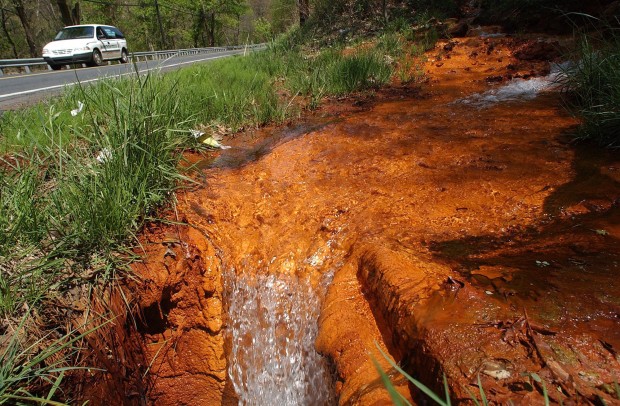Study: CO2 emissions from coal mine drainage higher than expected
-
Susan Phillips

Rick Smith / AP PHOTO
Acid mine drainage from the Potts Colliery near Shamokin, Pa., stains the creek bed orange. New research suggests these waters could also be a significant source of CO2 emissions.
Carbon dioxide emissions from mine water could be greater than previous estimates, according to new research from West Virginia University. The study calculated that CO2 emissions from 140 coal mine drainage sites in Pennsylvania could equal those from a small power plant.
“The numbers are higher than I expected to see,” said Dorothy Vesper, associate professor of geology at West Virginia University and the author of the study “Inorganic carbon dynamics and CO2 flux associated with coal-mine drainage sites in Blythedale PA and Lambert WV, USA.” Vesper’s paper was published in the peer-reviewed journal Environmental Earth Sciences in February.
Vesper says the findings indicate that CO2 emissions from coal mine drainage could be overlooked when thinking about the Earth’s overall release of carbon, and how those emissions are driving climate change.
“It would be interesting to know if this is important,” said Vesper. “There’s been a lot of research in recent years regarding CO2 evasion, that’s the idea that CO2 escapes from surface waters. And some of those numbers suggest it might be really important and has to be accounted for in a carbon budget.”
Vesper says scientists like herself have always known that mine water contains CO2, but she says calculating the amount of CO2 that escapes over time has always been done indirectly, using the alkalinity of the water. And this, she says, could have led to underestimating the CO2 emissions.
“Many people calculate carbon dioxide from alkalinity, or the capability of water to neutralize acid,” she said. “So the pH has to be above five, but if you have a lot of carbon dioxide dissolved in the water, it forces the pH to fall below five and people just dismiss it and ignore it,” Vesper said.
But Vesper is finding that very low pH waters, do have significant amounts of CO2.

Courtesy of the Western Pennsylvania Coalition for Acid Mine Reclamation
Acid mine drainage often turns a stream orange and smothers all aquatic life. In this case, aluminum has made the stream lifeless.
Mine drainage, a waste product associated with coal mining, is water that emerges from underground mines and discharges into rivers or streams. It is often orange in color and highly acidic. The contaminated water is created when iron sulfide is exposed to air and water, creating sulfuric acid and dissolved iron. The mine drainage water dissolves the surrounding limestone, which contains carbon dioxide. When the water reaches the surface, it’s not only undrinkable and unable to support aquatic life, it releases some of that CO2 into the atmosphere.
Vesper says quantifying that CO2 release was very difficult. But working with the Department of Energy’s National Energy Technology Lab, Vesper says the government agency was interested in figuring out the effectiveness of carbon sequestration, and how to measure potential leaks.
Scientists sometimes have to get pretty creative when collecting their data. In this case, researchers turned to breweries. “We were looking for a good way to measure CO2 in water, but I wanted to do it in the field,” she said.
So they looked to the beverage industry, breweries and soda manufacturers need to know exact amounts of CO2 for quality control. It turns out there was a handheld device called the CarboQC, manufactured in Austria by Anton Paar, that is a common tool for brewers.
“The beverage industry said to us, ‘you want to put this in a creek?'”
And that’s exactly what Vesper and her students did at two sites, one in Pennsylvania and one in West Virginia.
“I can put it in a backpack and haul it everywhere,” she said.
This instrument allowed her to get on the ground accurate measurements of CO2 at the point of discharge.
Vesper says the measurements were very accurate. But to paint a larger picture, she had to make some assumptions and use data gathered by the USGS at 140 mine sites across Pennsylvania, which was based on alkalinity measurements. So she’s not sure of the error rate when it comes to the big picture conclusions.
“I can’t tell you if I’m overestimating or underestimating the numbers,” she said.
To do that, she needs to gather more data using the CarboQC.
The research was funded by the National Energy Technology Lab. Her current funding has come through the National Science Foundation.
















